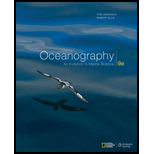
The reason why tides are referred to as shallow-water waves though they travel through all the oceans.
Answer to Problem 1TC
Tide waves are properly treated as shallow-water waves by the dynamic theory. The movements of the tidal crests are diverted, decelerated, and/or complicated by the continents when the Earth rotates. This intervention generates various patterns in the influx of tidal crests at different locations. Even if the tidal crests cross the abyssal depths, the occurrence of tides in deep waters is not possible because of their greater wavelengths.
Explanation of Solution
The dynamic theory of tides, which was proposed at first by Laplace, in 1775, gave a basic understanding of the difficulties of fluid motion to Newton’s innovation in celestial mechanics. The dynamic theory describes the differences between estimations based on Newton’s model and the detected tidal behaviors. It is known that tides refer to a form of wave.
The combined effect of the gravitational pull of the Moon and the Sun along with the rotation of the Earth in its orbit is the reason behind the occurrence of tides. Tides form the longest of every wave when it owns a wavelength that is equal to half of the circumference of the Earth. Contrasting to the other waves, these massive shallow-water waves would be never free of the influence of forces producing them and hence behave in unfamiliar way, however, they are usually predictable.
According to the equilibrium model, the tidal crests would continue to be immobile, directing steadily toward or away from the Moon or Sun, as the Earth is rotated underneath them. They seem to advance with a speed of around 1,600 kilometers per hour across the perfect water-covered Earth. Nevertheless, to facilitate the movement of a tidal crest at such a high speed, the ocean would have to be nearly 22 kilometers deep. It is known that the ocean’s average depth is merely 3.8 kilometers. Hence, tidal crests or tidal bulges travel as forced waves, and their velocity would be determined by the depth of the ocean.
It is to be noted that by definition, a deep-water wave would be deeper than half of its wavelength in water. The seismic sea waves would generally have a wavelength greater than 100 kilometers. An ocean that is deeper than 50 kilometers does not exist. Therefore, seismic sea waves, seiches, and tides always occur in water at a depth that to them is shallow or intermediate. The huge orbit circles of such waves flatten against a distant bottom that is lesser than half a wavelength away always.
The only one disparity from the model that the dynamic theory elucidates is tides’ behavior as shallow-water waves. The continents also have its role to play. When the Earth rotates, continents impede the tidal crests, divert, decelerate, and/or else complicate their movements. Such an intervention gives rise to different patterns in the influx of tidal crests at diverse locations.
Want to see more full solutions like this?
Chapter 11 Solutions
Oceanography: An Invitation to Marine Science (MindTap Course List)
 Applications and Investigations in Earth Science ...Earth ScienceISBN:9780134746241Author:Edward J. Tarbuck, Frederick K. Lutgens, Dennis G. TasaPublisher:PEARSON
Applications and Investigations in Earth Science ...Earth ScienceISBN:9780134746241Author:Edward J. Tarbuck, Frederick K. Lutgens, Dennis G. TasaPublisher:PEARSON Exercises for Weather & Climate (9th Edition)Earth ScienceISBN:9780134041360Author:Greg CarbonePublisher:PEARSON
Exercises for Weather & Climate (9th Edition)Earth ScienceISBN:9780134041360Author:Greg CarbonePublisher:PEARSON Environmental ScienceEarth ScienceISBN:9781260153125Author:William P Cunningham Prof., Mary Ann Cunningham ProfessorPublisher:McGraw-Hill Education
Environmental ScienceEarth ScienceISBN:9781260153125Author:William P Cunningham Prof., Mary Ann Cunningham ProfessorPublisher:McGraw-Hill Education Earth Science (15th Edition)Earth ScienceISBN:9780134543536Author:Edward J. Tarbuck, Frederick K. Lutgens, Dennis G. TasaPublisher:PEARSON
Earth Science (15th Edition)Earth ScienceISBN:9780134543536Author:Edward J. Tarbuck, Frederick K. Lutgens, Dennis G. TasaPublisher:PEARSON Environmental Science (MindTap Course List)Earth ScienceISBN:9781337569613Author:G. Tyler Miller, Scott SpoolmanPublisher:Cengage Learning
Environmental Science (MindTap Course List)Earth ScienceISBN:9781337569613Author:G. Tyler Miller, Scott SpoolmanPublisher:Cengage Learning Physical GeologyEarth ScienceISBN:9781259916823Author:Plummer, Charles C., CARLSON, Diane H., Hammersley, LisaPublisher:Mcgraw-hill Education,
Physical GeologyEarth ScienceISBN:9781259916823Author:Plummer, Charles C., CARLSON, Diane H., Hammersley, LisaPublisher:Mcgraw-hill Education,





